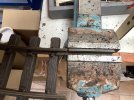I inherited lots of trains and track from my dad who passed 9 years ago. I have set up a double loop in the front yard and want to go from DC to DCC. I hear that I need to make sure the tracks are solidly connected. I've watched some videos regarding soldering jumper wires between each section of track and have tried to do the same. I find it near impossible and wondered if anyone has more information, a different approach or some other way to get this done?
Thanks Tom from San Diego
Thanks Tom from San Diego


